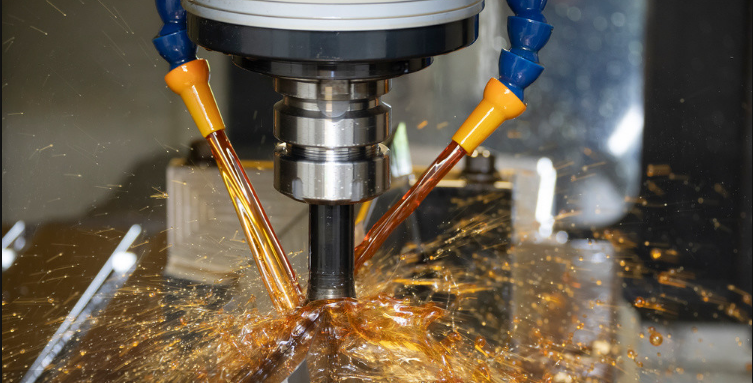
Privacy statement: Your privacy is very important to Us. Our company promises not to disclose your personal information to any external company with out your explicit permission.
![]() June 04, 2023
June 04, 2023
Cutting fluids can generally be divided into two series: water-insoluble (oil-based) and water-soluble (water-based) cutting fluids, oil-based cutting fluids (also known as cutting fluid), which are based on mineral oil and are used in harsh machining occasions, low viscosity ones are used in flushing and cooling occasions, such as deep hole machining, and high viscosity ones are used in intermittent cutting, such as gear cutting, heavy vehicle cutting, etc. Water-soluble cutting fluids can be divided into three categories based on the content of mineral oil and the size of droplets, including emulsions, semi synthetic cutting fluids, and fully synthetic cutting fluids. Emulsion is a relatively early traditional cutting fluid with a Base Oil content of over 60%. Its diluent is opaque and appears milky white. The Fully Synthetic Cutting Fluid does not contain any base oil, and its main components are rust inhibitors, surfactants, and some performance additives. All of its components are completely water-soluble and appear completely transparent after dilution; A Semi Synthetic Cutting Fluid with an oil content between the two.

In the experiment, No. 10 engine oil with lower viscosity was used as a naphthenic base oil. The use of naphthenic groups has a better effect on reducing the oil consumption of the first line total loss system. The prepared mother liquor is more transparent, uniform, and stable, with better lubrication performance than other total loss system oils. The price is also relatively cheap, which can effectively reduce costs and is suitable for mass production.

Water soluble antirust agent is the main antirust component of micro lotion. There are many commonly used types, such as MC ternary acid, sebacic acid, dodecanedioic acid, etc.

Surface activity is a key substance that emulsifies oil and water, mainly consisting of anionic, cationic, and non ionic surfactants. Micro lotion belongs to an unstable system in thermodynamics. Due to the effect of surface free energy, the specific gravity difference between water and oil, and the influence of Brownian motion in the system, if the emulsifier is selected improperly, oil droplets will coalesce and combine, leading to phase separation (i.e. demulsification). If the appropriate emulsifier is selected, demulsification will not occur. The selected surfactant is non-ionic surfactant SP80, whose HLB value is 4.3, and its lipophilicity is strong. The other is polyethylene ether alkyl (OP-10), whose HLB value is 14.5, and its hydrophilicity is strong. If a surfactant is used alone, the micro lotion can be stable in a short time, but it can be placed.

Selection of NO.6 pH regulator
The pH value of the micro lotion should be kept between 8 and 9. Too low pH value is easy to breed bacteria, which will lead to the corruption of the micro lotion, reduce the anti-corrosion performance of the micro lotion, and make the workpiece and equipment rust. However, too high pH value will harm the operator's skin, and also cause corrosion of aluminum. Aluminum is an amphoteric metal, and aluminum will react chemically in the environment with high alkaline value. Therefore, the pH value of the micro lotion must be controlled between 8 and 9. The micro lotion contains a certain amount of water, so the pH value can be adjusted with water-soluble alkaline materials. N-methyldiethanolamine (MDEA) is a good pH regulator, which is a water-soluble antirust agent with good performance. Proper addition will not cause gelation and precipitation of the micro lotion system. An appropriate amount of EDTA can be added to the micro lotion to adjust the pH value by dissolving it in 30% potassium hydroxide solution. EDTA can also reduce the hardness of water, further reduce the surface tension of the micro lotion system, and improve the transparency of the micro lotion.
The above is the Selection of rust inhibitors in aluminum alloy cutting fluid we have listed for you. You can submit the following form to obtain more industry information we provide for you.
You can visit our website or contact us, and we will provide the latest consultation and solutions
Send Inquiry
Most Popular
lastest New
Send Inquiry
Send Inquiry

Mr. James
Tel:0086-371-58651986
Fax:
Mobile Phone:+8613783582233
Email:sales@cn-lubricantadditive.com
Address:No.11 Changchun Road, High-Tech Zone, Zhengzhou, Henan
Related Products List
Mobile Site


Privacy statement: Your privacy is very important to Us. Our company promises not to disclose your personal information to any external company with out your explicit permission.

Fill in more information so that we can get in touch with you faster
Privacy statement: Your privacy is very important to Us. Our company promises not to disclose your personal information to any external company with out your explicit permission.